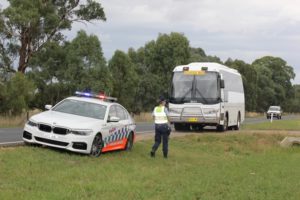“Why does it need a police car to get them to slow down?” That was the question asked by mother of two Danielle Phillips on Monday afternoon.
Cootamundra-Gundagai Regional Council (CGRC), Road Safety Officer, Anthony Carroll, was attending Gundagai Road, along with Cootamundra Local Area Command (LAC) Acting Sergeant Hannah Bloomfield, for a media campaign on school bus safety.
The campaign is to raise awareness that a 40km/h zone exists for all motorists when passing a school bus that has their wig wag lights flashing regardless of the signposted speed zone.
Mr and Mrs Phillips along with their children Abby, 8, and Lane, 9, volunteered to take part in a photo shoot to assist with the campaign. Their children attend Cootamundra Public School. Lane and Abby and catch their school bus on Gundagai Road. After taking photos with Acting Sergeant Hannah Bloomfield and the highway patrol car, Mrs Phillips made the comment “Why does it need a police car to get them to slow down?” Her husband Tristan agreed saying “That’s the first time we have seen traffic slow down, when the bus is stopping.”
CGRC Local Traffic Committee member Cr Charlie Sheahan said motorists need to think about their responsibilities when driving and be aware that these laws exist for the safety of our children.
“Every time we do this campaign, we get the same response from parents, children and bus operators. It takes a police car in situ to get motorists to slow down,” Cr Sheahan said. “Children have a short attention span; they are easily distracted and don’t have the capacity to judge distances and speeds travelled as well as adults. As motorists the onus is on us to be aware, obey the rules and drive safely.”
“It’s time to think about your responsibilities when driving, it’s time to think and act about the way you drive and what you can do to minimise the risk to yourself, your loved ones and other road users and in particular our kids,” Cr Sheahan added.
Some thought-provoking facts drivers may like to consideration when slowing down for stopped buses are:
- The typical stopping distance on reasonable road surfaces for vehicles travelling at 60 km/hour is 56m (longer than a Olympic size swimming pool) whilst for vehicles travelling at 50 km/hour the typical stopping distance is 37 m. For a vehicle travelling at 40 km/hour the stopping distance is 27m* (NSW Centre for Road Safety).
- Pedestrian fatality rates for being struck by a vehicle is a whopping 90% for vehicles travelling at 50 km/hour and 40% for vehicles travelling at 40 km /hour.
- A small reduction in speed below 50 km/hour significantly improves the survivability in the event of a pedestrian crash.
- The speed limits around school buses when the “wig wag” lights are flashing is 40 km/hour. Traffic travelling in the same direction as the school bus must slow to 40km/hour when the “wig wag” lights are flashing, even if the sign posted speed limit is 100km/hour. This applies to highways, regional and country roads, and lanes.
- School buses have different speed limits to the passing speed limits around emergency vehicles. Slow down and take care around school buses and in school zones.
- Children have a short attention span are easily distracted and are unpredictable. Please slow down at all schools and in particular take care when driving around schools in our villages. The children in these smaller schools may not be as aware of traffic as their counterparts in larger areas.
- CGRC has purchased more traffic counters, which have the capacity to record the speed of the traffic and volume of traffic using thoroughfares. These devices will enable Council to monitor traffic behavior, and report on problem areas to police and other authorities to make roads safer for everyone.
Photo and caption: Acting Sergeant Cootamundra LAC Hannah Bloomfield on Gundagai Road to assist with School Bus Safety Campaign, parents, children and bus operators all comment, that the only way to get motorists to slow down to 40km/hour at bus stops is to bring a police car out.

-END-

